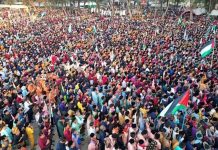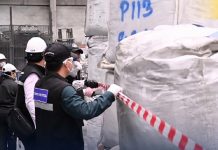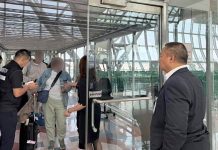BANGKOK (AP) — Police on Monday gave their most detailed explanation yet of who they believe was behind last month’s deadly bombing in Bangkok, for the first time publicly linking one of the suspects to previous blasts.
Authorities have said they believe the Aug. 17 bombing at the Erawan Shrine, which killed 20 people and injured more than 120, was carried out by a people smuggling gang seeking revenge for having their operation curbed.
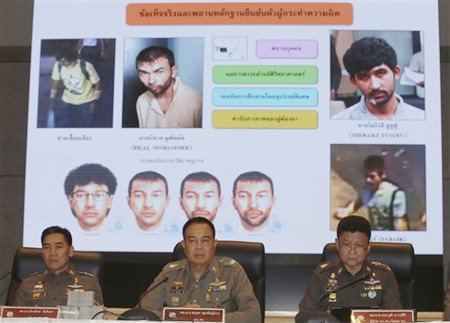 Thai National Police Chief Somyot Poomphanmuang, center, Deputy Police Chief Jakthip Chaijinda, left, and Police spokesman Prawut Thavornsiri sit in front of a chart of suspect bombers during the press conference. (AP Photo/Sakchai Lalit)
Thai National Police Chief Somyot Poomphanmuang, center, Deputy Police Chief Jakthip Chaijinda, left, and Police spokesman Prawut Thavornsiri sit in front of a chart of suspect bombers during the press conference. (AP Photo/Sakchai Lalit)
While a presentation to the media Monday mostly summed up information released in recent days, National Police Chief Somyot Poomphanmuang said that two different groups may have been involved, and that a Thai suspect still at large had been tied to bombings in 2010 and 2014.
The 2010 bombing was loosely linked to “Red Shirt” activists who earlier that year staged militant anti-government protests.
Skepticism about the police explanation on the shrine attack has abounded, because of leaks, contradictions and misstatements. So police went to some lengths Monday to lay out all the links they could in the alleged conspiracy in their presentation in an effort to boost their credibility.
 Reporters and photographers take photos of a chart of suspect bombers after the press conference in Bangkok.(AP Photo/Sakchai Lalit)
Reporters and photographers take photos of a chart of suspect bombers after the press conference in Bangkok.(AP Photo/Sakchai Lalit)
One series of computer-generated sketches tried to show how the original wanted poster for the man accused of planting the bomb resembled the suspect now in custody, without the disguise he wore at the scene of the crime.
They are confident that the two men in custody, identified as Adem Karadag — also known as Bilal Mohammed — and Mieraili Yusufu, are responsible for the bombing. There are warrants out for 15 other people in connection with the case.
 Thai National Police Chief Somyot Poomphanmuang, right, hands over 3 million baht ($84,000) cash reward to Deputy Police Chief Jakthip Chaijinda, representing Thai police for arresting the Erawan Shrine bombing suspects.(AP Photo/Sakchai Lalit)
Thai National Police Chief Somyot Poomphanmuang, right, hands over 3 million baht ($84,000) cash reward to Deputy Police Chief Jakthip Chaijinda, representing Thai police for arresting the Erawan Shrine bombing suspects.(AP Photo/Sakchai Lalit)
Karadag, who police believe is Turkish, is thought to be the yellow-shirted man who planted the bomb and Yusufu, who carries a Chinese passport, is believed to have detonated the bomb. They both faces charges of murder and attempted murder, among other crimes.
Police released details of one of the most-recently named suspects, a Thai man identified as Ord Payungwong or Yongyuth Pobkeaw. He was tied to two apparently accidental but fatal explosions in 2010 and 2014, and police said he could have taken part in assembling last month’s bomb.
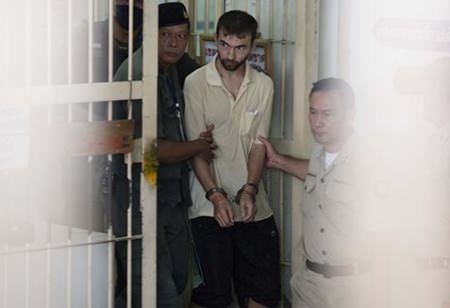 Adem Karadag AKA Bilal Mohammed (AP Photo/Wason Wanichakorn)
Adem Karadag AKA Bilal Mohammed (AP Photo/Wason Wanichakorn)
Metropolitan Police Chief Srivara Rangsipramanakul said Ord “has committed at least nine crimes so far, never been arrested and doesn’t have a Thai identification number.” All Thai citizens are supposed to carry ID cards, which also ensure that their photos and other details are on file.
The 2010 explosion in the outskirts of northern Bangkok partially destroyed a five-story building and killed four people, just five months after the army violently suppressed a two-month political protest by supporters of former Prime Minister Thaksin Shinawatra, who was ousted by a 2006 military takeover.
The 2014 explosion on a motorcycle killed two men and led to the discovery of several pipe bombs in a nearby apartment, in the same general neighborhood where several of the Erawan Shrine bombers are believed to have stayed. Police had previously linked the 2010 and 2014 blasts.
The link to the earlier blasts suggested that some of the suspects were involved in activities other than people smuggling. Police have suggested that some of the people involved in the shrine bombing may have been hired by the people smugglers.
Copyright 2015 The Associated Press. All rights reserved. This material may not be published, broadcast, rewritten or redistributed.


